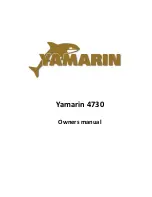
G
E N E R A L
I
N F O R M A T I O N
3–4
S
HALLOW
W
ATER
Most boats that become grounded can be floated off with engine(s) tilted to reduce the draft at
the transom. With motors tilted, try rocking the boat from side to side to break the suction of mud
from the keel. Move passengers or heavy objects from the point where the boat is grounded. Do
not lower or start the engine(s) until the boat is clear of the ground. Refer to page 63 in
Sportfish,
Cruisers, and Yachts Owner’s Manual
.
Be mindful of water level fluctuations when boating in water with tidal changes. If you are
grounded on an incoming tide, you can wait until the tide is high enough to refloat your boat.
However, on an outgoing tide, quick action should be taken to refloat your boat. If this is not
possible, set an anchor to keep the boat from becoming driven further aground. Set the anchor to
counter the action of the wind or current. The anchor, in some cases, can also be used to pull the
boat free.
Many inland areas have rocks and stumps which could crack or puncture a fiberglass hull. Be
familiar with the boating area, and use caution in shallow water.
G
ENERAL
I
NFORMATION
O
N
B
OAT
H
ANDLING
The best method of learning how to handle and obtain the best performance from your boat is
to practice and experiment. After several hours of operation, you should experiment with the
throttle settings to discover the setting that will be the most comfortable and economical range for
your particular load conditions.
We suggest that you make a speed and RPM chart to obtain the most economical operation.
Operate the boat at various speeds and check the fuel consumption. Compute the amount of
operating time remaining when the fuel gauge has only one bar remaining on the display. Make a
log of this type of information and have it available when using your boat. Other statistics you
may want to determine could include the following:
• Minimum speed for effective steering.
• Turning radius at different speeds.
• Response to steering at low speeds.
• Accelerating and deceleration rates.
• Time and distance to bring the boat to a stop at different speeds.
• Control of the boat in close quarters.
• Time required to bring the boat on plane.
Also read the section in
Sportfish, Cruisers, Yachts Owner’s Manual
beginning on page 59
for
information on safe operating speed.
C A U T I O N
Do not lower or start engines if the propeller is in mud or sand. Wait until the boat is refloated to
avoid damage to the cooling system of your engine.
!
Содержание FISHERMAN 230
Страница 2: ......
Страница 6: ...T A B L E O F C O N T E N T S ...
Страница 10: ...W E L C O M E 1 4 ...
Страница 24: ...G E N E R A L I N F O R M A T I O N 3 6 ...
Страница 32: ...I N S T R U M E N T A T I O N A N D S W I T C H E S 5 4 ...
Страница 42: ...M A I N T E N A N C E A N D S E R V I C E 6 10 ...
Страница 72: ...L I M I T E D W A R R A N T Y 9 4 ...
















































